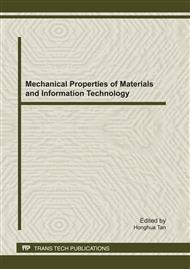[1]
Bin Shi, Hongzhong Xu, Dan Zhang and et al.: Feasibility study on application of BOTDR to health monitoring for large infrastructure engineering. Chinese Journal of Rock Mechanics and Engineering. Forum Vol. 3 (2004), pp.493-499.
Google Scholar
[2]
Bin Shi, Xuejun Xu, Di Wang and et al.: Study on BOTDR-based distributed optical fiber strain measurement for tunnel health diagnosis. Chinese Journal of Rock Mechanics and Engineering. Forum Vol. 24 (2004), pp.2623-2628.
Google Scholar
[3]
Junyi Zhang, Echuan Yan, Xingqiao Xue and et al.: The application of BOTDR on geological hazards monitoring in Three Gorges. Earth and Environment. Forum Vol. 33 (2005), pp.355-358.
Google Scholar
[4]
Xiaozhen Jiang, Mingtang Lei, Yuan Chen and et al.: An experiment study of monitoring sinkhole collapse by using BOTDR optical fiber sensing technique. Hydrogeology & Engineering Geology. Forum Vol. (2006), pp.75-79.
Google Scholar
[5]
Jie Ge: Application of BOTDR to monitoring sea dyke subsidence. Rock and Soil Mechanics. Forum Vol. 30 (2009), pp.1856-1860.
Google Scholar
[6]
Jie Liu, Bin Shi, Dan Zhang and et al.: Experiment study of foundation pit monitoring using BOTDR-based on distributed optical fiber sensor. Rock and Soil Mechanics. Forum Vol. 27 (2006), pp.1224-1228.
Google Scholar
[7]
Chunde Piao, Bin Shi, Youqun Zhu and et al.: Distributed monitoring of bored pile compression deformation based on BOTDR. Hydrogeology & Engineering Geology. Forum Vol. (2008), pp.80-83.
Google Scholar
[8]
Zhihuai Huang, Handong Liu: Experimental study of the applications of BOTDR technology to strain monitoring of GFRP anchor bar. Journal of North China Institute of Water Conservancy and Hydroelectric Power. Forum Vol. 26 (2005), pp.49-51.
Google Scholar
[9]
KURASHIMA T, HORIGUCHI T and et al. Distributed strain measurement using BOTDR improved by taking account of temperature dependence of Brillouin scattering power. ECOC 97, Sep, Conference Publication (1997), pp.119-122.
DOI: 10.1049/cp:19971381
Google Scholar
[10]
PARKER T R, FARHADIROUSHAN M, HAND EREK V A and et al. Temperature and strain dependence of the power level and frequency of spontaneous Brillouin scattering in optical fibers. Opt. Lett. Forum Vol. 22(1997), pp.787-789.
DOI: 10.1364/ol.22.000787
Google Scholar
[11]
Wenbin Suo, Bin Shi, Wei Zhang and et al.: Study on calibration of distributed optical fiber sensors based on BOTDR. Chinese Journal of Scientific Instrument. Forum Vol. 27 (2006), pp.985-989.
Google Scholar
[12]
Jingjun Luo, Junyi Zhang, Youlong Gao and et al.: Study on temperature influence on BOTDR-monitored data. Study on Optical Communications. Forum Vol. (2009), pp.45-48.
Google Scholar


